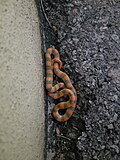| Image | Scientific name | Common name | Distribution |
|---|
 | Sonora aemula
(Cope, 1879) | filetail ground snake | |
 | Sonora annulata
(Baird, 1859) | Colorado Desert shovelnose snake | SE California, Arizona, Baja California |
 | Sonora cincta
(Cope, 1861) | Arizona ground snake, banded burrowing snake, horse snake, red and black ground snake, Sonora ringed snake [1] | USA (S Arizona), Mexico (N Baja California Sur, W Sonora) |
 | Sonora episcopa
(Kennicott, 1859) | ground snake | USA (Missouri, N Arkansas, Kansas, Oklahoma, Texas, SE Colorado, S/E New Mexico), Mexico (Coahuila) |
 | Sonora fasciata
(Cope, 1892) | variable sand snake, banded sand snake | Mexico (Baja California) |
| Sonora michoacanensis
(Dugès, 1884) | Michoacán ground snake | Mexico (Colima, Guerrero, Michoacan; Morelos, Puebla) |
| Sonora mosaueri
Stickel, 1938 | Mosauer's ground snake | Mexico (Baja California Sur) |
| Sonora mutabilis
Stickel, 1943 | Michoacán ground snake | Mexico (Jalisco, Nayarit, Aguascalientes, southern Zacatecas, S Sinaloa) |
 | Sonora occipitalis
(Hallowell, 1854) | western shovelnose snake | USA (SE California, S Nevada, SW Arizona), Mexico (Baja California Norte) |
| Sonora palarostris
Klauber, 1937 | Sonoran shovelnose snake | USA (S Arizona), Mexico (Sonora) |
| Sonora savagei
Cliff, 1954 | Savage's sand snake [3] | Mexico (Baja California) |
 | Sonora semiannulata
Baird & Girard, 1853 | western ground snake | USA (W Texas, New Mexico, Arizona, Oklahoma, S Colorado, S Kansas, SW Missouri, SE Utah, California, Arkansas), Mexico (N Sonora, Chihuahua, Coahuila, Tamaulipas, NW Nuevo León, NE Durango) |
 | Sonora straminea
(Cope, 1860) | variable sand snake | Mexico (S Baja California Sur, Sinaloa) |
| Sonora taylori
(Boulenger, 1894) | Taylor's ground snake [3] | S Texas, adjacent Mexico |
|








